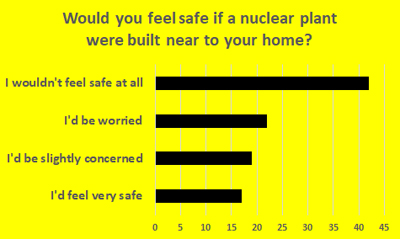Nuclear Safety
How Comfortable Are Children With Nuclear Power?

Global warming is the biggest threat to life on Earth. Human activities, particularly the burning of fossil fuels, are saturating the atmosphere with greenhouse gasses. Carbon dioxide from coal and gas-powered power stations is heating the planet and causing mass extinctions, melting ice caps and, if not stopped before it is too late, has the potential end to all life on our planet.
Clearly if we want to stop global warming then an alternative source of power is required. Renewable energy is seen as the answer but there is a limit to how much electricity we can get from it. An alternative source of “clean” energy is nuclear power, though this has issues of its own.
From previous surveys we have found that children are very enthusiastic about environmental matters, including tackling climate change. So, for this week’s survey we decided to ask them how safe they feel with nuclear power. We put the following question to 1,393 schoolchildren: “Would you feel safe if a nuclear plant were built near to your home?”. There was a choice of four possible answers, ranging from “very safe” to “not safe at all”.
Children Do Not Feel Safe With Nuclear Power
The majority of our respondents (42%) said that they would not feel at all safe if a nuclear plant were built near to their home. That is bad news for the nuclear industry. There are currently eight nuclear power stations within the UK with another four proposed. Though with future generations so negative towards them then not all of these might go ahead.
An almost equal number of our respondents were in the middle ground. 22% of children said they would be worried and 19% slightly concerned. Adding those together we have a total of 41% of schoolchildren who would have some reservations to a nuclear power station being built near to them.
The most revealing result from our survey is the number of children who said that they would feel very safe. This was a lowly 17% which means that fewer than one in six of the younger generation are confident that nuclear power is safe. This would suggest that, rather than focussing on nuclear power as the solution to climate change, we should instead be investing more in renewable energy sources like, solar, wind or wave power.
How Safe Is Nuclear Power?
Since the very first nuclear power plant went into action in the Soviet Union in 1954, there have been a total of 140 accidents – an average of just over two per year. That sounds very bad but the number of casualties tells a different story. The vast majority have caused no casualties at all, and the few that did (for the most part) killed no more than four people, and they were workers at the respected plants.
There have been a handful of major incidents though. The most famous of these is the Chernobyl disaster of 1986 which killed 50 people with radiation sickness and another 4,000 with cancer. The Fukushima incident in Japan in 2006 killed 2 people directly and another 573 through related illness. The UK’s worst nuclear incident occurred at the Windscale (now Sellafield) plant in 1957. It contaminated dairy farms with radiation and caused around 250 cases of cancer.
Most incidents at nuclear power stations have been controlled before they can cause much damage. However, it is clear that the worst accidents are very major events. So, how safe are they really?
Research conducted by the Max Planck Institute for Chemistry suggests that, with the current number of nuclear reactors worldwide, reactor accidents caused by a core meltdown (the problem with the Chernobyl and Fukushima incidents) should be expected once every ten to twenty years.
That seems like a very frightening statistic, until you work out the chances per individual power station. The researched was calculated on a total of 440 nuclear power stations. If one of those is expected to have an accident every 15 years then the chances for each individual station are one in six thousand. You could live safely beside a nuclear power station for 6,000 years before there was a major accident there.
Another thing to consider is the number of fatalities caused by nuclear power in relation to fossil fuel. As well as all the damage inflicted by global warming (which could potentially kill billions), fossil fuels also produce air pollution in the form of particulate matter in the air we breathe. Research carried out in a joint venture by British and American universities found that, in 2018, 8.7 million people were killed by breathing in particles from coal powered power stations, car exhausts and other sources. When you compare that to the fewer than 10,000 killed by nuclear plants over their 67-year history, nuclear power is not as harmful as fossil fuels by a very long way.
CHILDREN’S SURVEYS ON OVER 70 DIFFERENT SUBJECTSFull Results of our "Nuclear Safety” Survey
Here are the results from the 1,393 children who answered our question "Would you feel safe if a nuclear plant were built near to your home?" The survey was conducted in the week ending 6th June 2021.
| Would you feel safe if a nuclear plant were built near to your home? | Percentage of Respondents |
|---|---|
| I'd feel very safe | 17% |
| I'd be slightly concerned | 19% |
| I'd be worried | 22% |
| I wouldn't feel safe at all | 42% |



